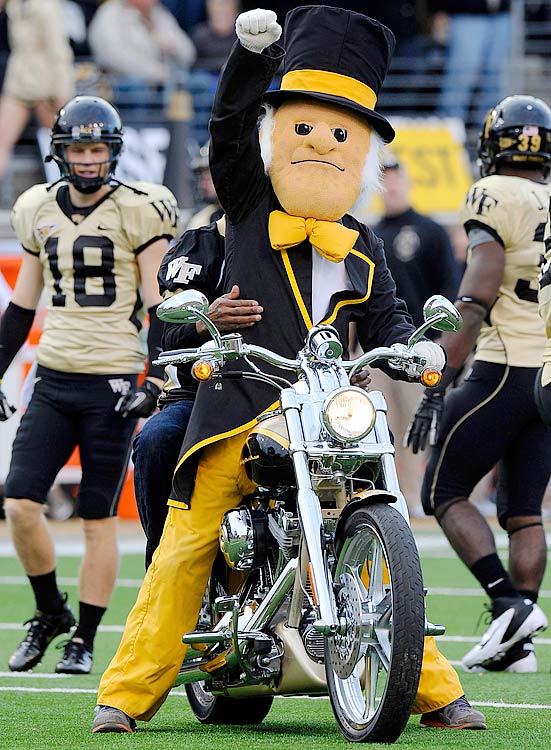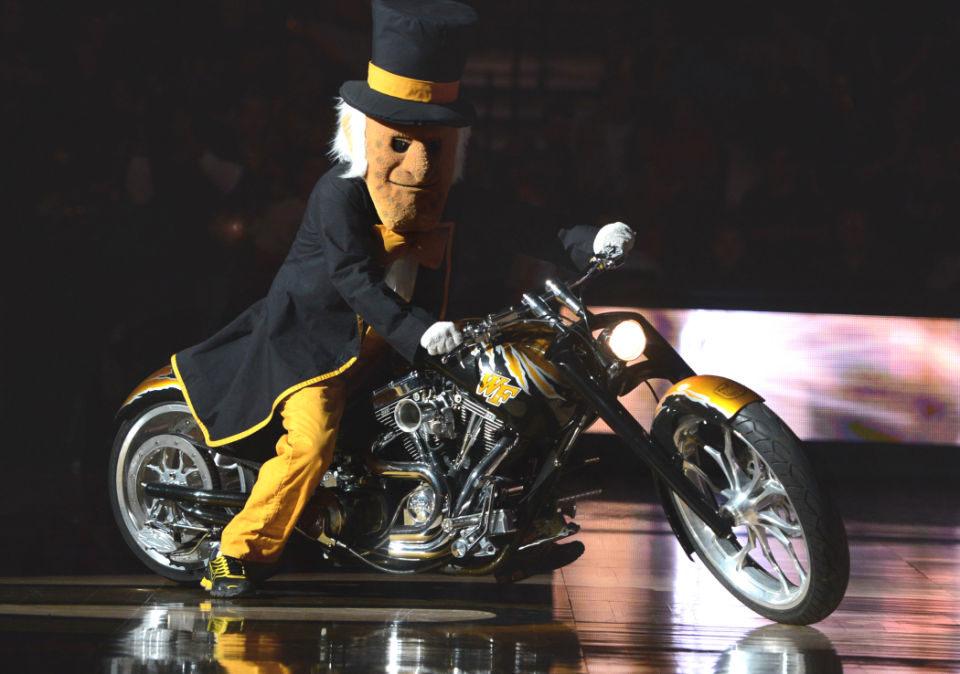Unveiling The Spirit Of Wake Forest: A Comprehensive Guide To The Wake Forest Mascot
Wake Forest mascot holds a special place in the hearts of Demon Deacon fans and the entire Wake Forest University community. The mascot embodies the spirit, tradition, and pride of the institution. From its historical roots to its modern-day significance, the Wake Forest mascot plays a vital role in uniting students, alumni, and supporters. In this article, we will explore the rich history, evolution, and cultural importance of the Wake Forest mascot.
The Wake Forest mascot is not merely a symbol but a representation of the university's values and identity. As one of the most recognizable figures in college sports, the mascot has become synonymous with Wake Forest's competitive spirit and commitment to excellence. Over the years, it has evolved into a beloved figure that inspires fans and fosters a sense of community.
Whether you're a long-time supporter of Wake Forest University or someone new to the Demon Deacons' world, this article will provide you with an in-depth understanding of the mascot's history, significance, and cultural impact. So, let's dive into the fascinating story of the Wake Forest mascot and discover what makes it such an integral part of the university's legacy.
Table of Contents
- The History of Wake Forest Mascot
- Biography and Background
- Symbolism Behind the Wake Forest Mascot
- Evolution of the Wake Forest Mascot
- The Role of the Wake Forest Mascot in Sports
- Fan Engagement and Community Building
- Mascot Traditions and Events
- Cultural Impact of the Wake Forest Mascot
- Comparison with Other College Mascots
- The Future of Wake Forest Mascot
The History of Wake Forest Mascot
The origins of the Wake Forest mascot date back to the early days of the university when the school adopted the nickname "Demon Deacons." This nickname emerged in the early 20th century, inspired by the university's Baptist roots and its commitment to religious education. The term "Deacon" refers to a title in the Baptist church, symbolizing service and leadership.
Over the years, the Wake Forest mascot has undergone several transformations. Initially, the mascot was represented as a more traditional figure, but as the university's identity evolved, so did the mascot's image. Today, the mascot is a lively and engaging character that embodies the spirit of Wake Forest University.
Early Days of the Demon Deacon Mascot
In the early days, the Wake Forest mascot was primarily depicted in illustrations and logos. It wasn't until the 1980s that a live mascot costume was introduced, bringing the Demon Deacon to life on the field and in campus events. This addition helped create a more interactive and engaging experience for fans and students alike.
Biography and Background
The Wake Forest mascot, known as the Demon Deacon, is a fictional character that represents the university's values and traditions. While not a real person, the mascot's persona is crafted to reflect the qualities that Wake Forest University stands for, including integrity, leadership, and community spirit.
| Attribute | Details |
|---|---|
| Name | Demon Deacon |
| Role | University Mascot |
| First Appearance | 1920s |
| Symbolism | Baptist Deacon and Athletic Spirit |
Symbolism Behind the Wake Forest Mascot
The Wake Forest mascot is rich in symbolism, representing the university's unique identity and values. The Demon Deacon embodies both the religious heritage of the university and its competitive spirit in athletics. This duality makes the mascot a powerful symbol of unity and pride for the Wake Forest community.
Key Symbolic Elements
- Deacon Title: Represents the university's Baptist roots and commitment to service.
- Demon Nickname: Symbolizes the competitive and spirited nature of Wake Forest's athletic teams.
- Colors: The use of black and gold in the mascot's design reflects the university's official colors.
Evolution of the Wake Forest Mascot
The Wake Forest mascot has undergone significant changes over the years, reflecting the university's growth and evolution. From its early days as a simple illustration to its current status as a dynamic and engaging character, the mascot has adapted to meet the needs of modern fans and students.
Major Transformations
In the 1980s, the introduction of a live mascot costume marked a turning point in the mascot's history. This allowed the Demon Deacon to interact more directly with fans and participants at sporting events and campus activities. Over the years, the costume design has been updated to enhance its appeal and functionality, ensuring that the mascot remains a beloved figure in the Wake Forest community.
The Role of the Wake Forest Mascot in Sports
The Wake Forest mascot plays a crucial role in the university's sports programs, serving as a rallying point for fans and athletes alike. Whether it's leading cheers at football games or participating in community events, the Demon Deacon is a constant presence that inspires and motivates.
Key Responsibilities
- Engaging fans and creating a lively atmosphere at sporting events.
- Representing Wake Forest University at community events and outreach programs.
- Upholding the university's values and traditions through its actions and presence.
Fan Engagement and Community Building
One of the most important functions of the Wake Forest mascot is fostering a sense of community among fans and students. Through its interactions and participation in various events, the Demon Deacon helps create lasting memories and strengthens the bonds between members of the Wake Forest family.
Ways the Mascot Engages Fans
- Performing at games and events to entertain and inspire.
- Participating in social media campaigns to connect with fans online.
- Visiting local schools and organizations to promote community involvement.
Mascot Traditions and Events
The Wake Forest mascot is deeply intertwined with the university's traditions and special events. From Homecoming celebrations to championship games, the Demon Deacon is a central figure in many of the most memorable moments in Wake Forest history.
Notable Traditions
- Leading the crowd in cheers and chants at football and basketball games.
- Participating in the annual Homecoming Parade and festivities.
- Attending alumni gatherings and reunion events.
Cultural Impact of the Wake Forest Mascot
Beyond its role in sports and campus events, the Wake Forest mascot has a significant cultural impact both within the university and beyond. The Demon Deacon serves as a symbol of pride and identity for the Wake Forest community, inspiring generations of students and fans.
Contributions to University Culture
- Promoting school spirit and unity among students, faculty, and alumni.
- Encouraging community involvement and service through its outreach efforts.
- Representing Wake Forest University in a positive and impactful way.
Comparison with Other College Mascots
While the Wake Forest mascot shares similarities with other college mascots, it stands out in several key ways. The unique combination of religious symbolism and athletic spirit sets the Demon Deacon apart from its peers, making it a distinctive and memorable figure in the world of college sports.
Distinctive Features
- Religious heritage reflected in the "Deacon" title.
- Competitive spirit embodied by the "Demon" nickname.
- Engaging and interactive presence at events and activities.
The Future of Wake Forest Mascot
Looking ahead, the Wake Forest mascot is poised to continue its important role in the university's community and culture. With ongoing updates to its costume and interactions, the Demon Deacon will remain a vital part of Wake Forest's identity for years to come.
As technology advances, there may be new opportunities for the mascot to engage with fans in innovative ways, such as through virtual and augmented reality experiences. These developments will further enhance the Demon Deacon's ability to inspire and unite the Wake Forest community.
Conclusion
The Wake Forest mascot is much more than just a symbol; it is a powerful representation of the university's values, traditions, and spirit. From its historical roots to its modern-day presence, the Demon Deacon continues to play a vital role in fostering a sense of community and pride among Wake Forest fans and supporters.
We invite you to share your thoughts and experiences with the Wake Forest mascot in the comments below. Your feedback and stories help enrich our understanding of this beloved figure. Additionally, feel free to explore other articles on our site for more insights into college sports and university traditions.
Thank you for reading, and Go Deacs!
Article Recommendations



Detail Author:
- Name : Santina Grady
- Username : hirthe.emery
- Email : welch.luna@parker.net
- Birthdate : 1994-02-06
- Address : 9226 Mylene Place Suite 157 Port Jaydon, UT 32666
- Phone : +1-640-359-8652
- Company : Treutel, Barrows and Lakin
- Job : Medical Technician
- Bio : Aut ut fugiat suscipit enim ut facere omnis. Ullam est est neque rem nam blanditiis voluptatum est. Deserunt voluptates blanditiis animi. Quisquam modi dignissimos aperiam sit eum.
Socials
linkedin:
- url : https://linkedin.com/in/myah.hayes
- username : myah.hayes
- bio : Optio eaque rerum ex ut.
- followers : 133
- following : 2497
instagram:
- url : https://instagram.com/hayes2018
- username : hayes2018
- bio : Modi alias dolorem qui ipsum voluptas. Pariatur culpa nemo rem.
- followers : 1913
- following : 892
tiktok:
- url : https://tiktok.com/@myahhayes
- username : myahhayes
- bio : Qui et repudiandae mollitia expedita blanditiis dolores occaecati.
- followers : 5318
- following : 2910